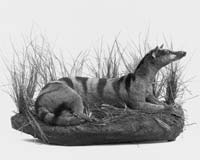
The number of circulating endothelial progenitor cells in an individual’s blood –– the precursor cells to those that line the insides of blood vessels –– may be an indicator of overall cardiovascular health, according to research by scientists at the National Heart, Lung, and Blood Institute (NHLBI) and Emory University School of Medicine. The research was published in the Feb. 13 issue of the New England Journal of Medicine.
The endothelial cells lining the blood vessels provide essen

For the first time ever, a University of Alberta researcher has discovered that an animal species has changed its genetic make-up to cope with global warming. In the past, organisms have shown the flexibility–or plasticity–to adapt to their surroundings, but this is the first time it has been proven a species has responded genetically to cope with environmental forces.
Dr. Stan Boutin, from the Department of Biological Sciences at the University of Alberta in Edmonton, has been studying a

Answer one of natural history’s most intractable questions
All of Madagascar’s living Carnivora (an order of mammals that includes dogs, cats, bears, hyenas and their relatives) descended from a single species that dispersed from Africa to Madagascar, apparently floating across the ocean barrier aboard wayward vegetation about 24 million to 18 million years ago. Previously, scientists believed that Madagascar’s seven living species of native Carnivora represented two to four

Scientists from the University of Leicester are taking revolutionary research further with the potential to offer new hope for knee-injury victims.
They are following up international research that aims to improve knee cartilage repair techniques, termed ‘chrondrocyte implantation’. The procedure, developed in Sweden ten years ago, involves growing a patient’s knee cartilage cells in a laboratory, which are then implanted through open knee surgery. Recent exciting developments revolve

Highlights, including authors and their institutions
The following highlights summarize research papers in Geophysical Research Letters (GL), Journal of Geophysical Research – Solid Earth (JB), Journal of Geophysical Research – Atmospheres (JD), and Journal of Geophysical Research – Planets (JE). The papers related to these Highlights are printed in the next paper issue of the journal following their electronic publication.
1. Another Great Salinity Anomaly?

A team of scientists supported by the National Institute of Arthritis and Musculoskeletal and Skin Diseases (NIAMS) and other parts of the National Institutes of Health (NIH) and the private sector, have discovered a genetic “signature” present in some patients with systemic lupus erythematosus (SLE) who develop such life-threatening complications as blood disorders, central nervous system damage and kidney failure.
Using DNA microarrays — small silicon chips that contain tiny amounts of tho

– new calculation confirms standard model of particle physics. Contribution of hadronic vacuum polarization determined with unprecedented accuracy. The magnetic moment of the muon is an important precision parameter for…
Technique may prevent formation of unwanted waves that siphon off needed energy. Heating plasma to the ultra-high temperatures needed for fusion reactions requires more than turning the dial on a…

An international team of astronomers, led by researchers from the Astronomical Observatory of the University of Warsaw, have identified a new class of cosmic X-ray sources. The findings have been…

How deubiquitinases USP53 and USP54 cleave long polyubiquitin chains and how the former is linked to liver disease in children. Deubiquitinases (DUBs) are enzymes used by cells to trim protein…

Conceptual blueprint to analyze experimental catalyst data. Machine learning (ML) models have recently become popular in the field of heterogeneous catalyst design. The inherent complexity of the interactions between catalyst…

Antibody that Neutralizes Inhibitory Factors Involved in Nerve Regeneration Leads to Enhanced Motor Function after Acute Spinal Cord Injury. Researchers at 13 clinics in Germany, Switzerland, the Czech Republic and…

How simulations help manufacturing of modern displays. Modern materials must be recyclable and sustainable. Consumer electronics is no exception, with organic light-emitting diodes (OLEDs) taking over modern televisions and portable…

“Neurons that fire together, wire together” describes the neural plasticity seen in human brains, but neurons grown in a dish don’t seem to follow these rules. Neurons that are cultured…

The quest for sustainable energy solutions has been a major focus of scientific research for decades. Solar energy, a clean and renewable source, has emerged as a promising alternative to…

With a processing speed a billion times faster than nature, chip-based laser neuron could help advance AI tasks such as pattern recognition and sequence prediction. Researchers have developed a laser-based…

New technology could remotely identify various types of plastics, offering a valuable tool for future monitoring and analysis of oceanic plastic pollution. Researchers have developed a new hyperspectral Raman imaging…

Artificial Intelligence (AI) has established a strong presence across industries, large and small. The “VoBaKI” research project has empowered small and medium-sized enterprises (SMEs) with an innovative tool to independently…